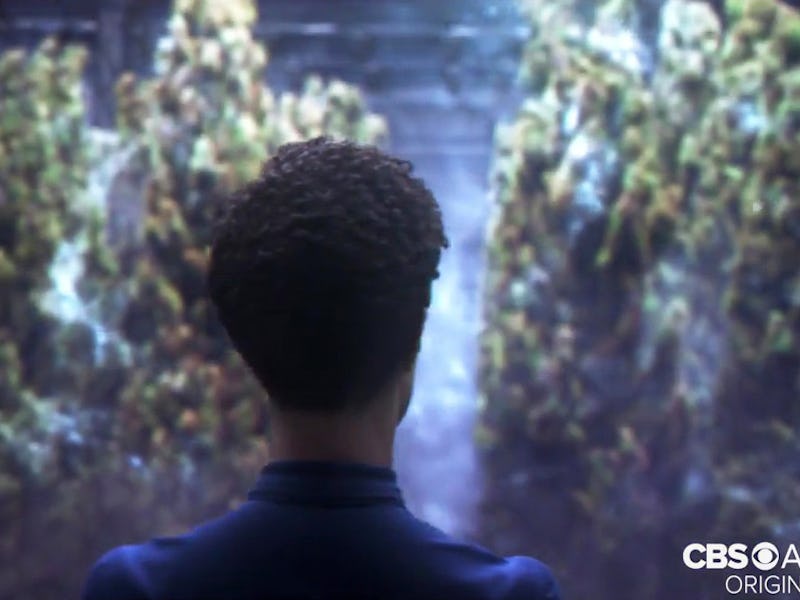'Star Trek' Moves Into the Weird, Real Frontier of Space Mushrooms

In Star Trek: Discovery, astromycologist Lieutenant Paul Stamets, the resident expert on space mushrooms, reveals that the entire Star Trek universe revolves around an unexpected life form: spores. In the third episode, Stamets uses the science of fungi to argue that there’s no difference between physics and biology at the quantum level, explaining that spores are the “pro-generators of panspermia” and the “building blocks of energy across the universe.”
While much of the science behind Stamets’ theory — that all galactic life sprang from spores — is fictional, a surprising amount of what he says about space mushrooms is rooted in very real and very weird mushroom science. For starters, his character’s namesake is a famous real-life mycologist named Paul Stamets who dreams of terraforming space with fungi. Furthermore, his idea that fungi could thrive in outer space is not entirely crazy. It’s unlikely, says University of California, Berkeley mycologist Thomas Jenkins — but it’s possible. We simply don’t know enough about mushrooms to say.
“We only know of, and this is a generous estimate, about five percent of the fungal biodiversity that exists,” Jenkins, a National Science Foundation postdoctoral research fellow, tells Inverse.
“We’re definitely still trying to learn all we need to know about what’s here on Earth, and when we have a better understanding of its functions, we can learn how biodiversity evolved here.”
Burnham encountering Stamets' spore experiments on Star Trek: Discovery.
Mycology is the branch of biology dedicated to the study of fungi — tough eukaryotes considered to be some of the least studied and most misunderstood organisms out there. Their bizarre hardiness and their ability to live on literal waste have led some real-life scientists to seriously consider Lieutenant Stamets’ ideas about the possibility of mushrooms in space, where conditions are harsh and resources are extremely scarce.
In 2016, a team of NASA scientists theorized that fungi could indeed survive on Mars. They proposed this after they exposed two Antarctic species of fungi, Cryomyces antarcticus and Cryomyces minteri, to Martian-like conditions for 18 months and discovered that 60 percent of the samples actually survived.
It’s “reasonable to assume that some form of life would specialize in the decomposition of biological debris on another Goldilocks planet,” Nicholas Money, Ph.D., a professor of biology at Miami University and author of Mushrooms: A Natural and Cultural History, tells Inverse. However, he points out, we obviously can’t be certain that life elsewhere will resemble life on Earth.
“These organisms might well develop some of the characteristics of the fungi,” Money says. “But don’t expect to find a fly agaric mushroom in another galaxy!”
It’s a bit of a bummer that aliens probably aren’t out there eating magic mushrooms native to other planets, but Money says the possibility that we can bring fungus from Earth to space remains — and could be key to human survival away from home. Mushroom-forming fungi capable of recycling organic materials or detoxifying waste, for example, could be useful for space pioneers, though he points out that mushrooms don’t have enough nutritional value to be useful space food.
What’s really going to be useful if humans want to make it to deep space, he says, is the fungus Saccharomyces cerevisiae, which is the yeast used in brewing, baking, and the manufacturing of biofuels and drugs.
“Human reliance on this single-celled fungus runs so deep that it would be unimaginable to travel anywhere in the cosmos without it,” says Money.
“Human civilization, such as it is, would not have developed without our 10,000-year old marriage with yeast. Yeast has always been more important to us than any fungus that produces mushrooms.”
A culture plate of Saccharomyces cerevisiae yeast.
Unfortunately, there’s a danger associated with bringing fungi to space. Jenkins is worried, in particular, about the possibility of inadvertently causing the spread of an invasive species in space. What happens if we can’t control the spread of mushrooms, he wonders, and they cause damage to extraterrestrial life?
There’s evidence that they’re capable of doing so. In July, NASA researchers discovered that certain kinds of fungi — including pathogens that can colonize the human body and cause allergies and skin infections, increase in number while humans live in small, closed habitats like the International Space Station.
“Fungi are extremophiles that can survive harsh conditions and environments like deserts, caves, or nuclear accident sites, and they are known to be difficult to eradicate from other environments including indoor and outdoor space,” study co-author and NASA Jet Propulsion Laboratory scientist Kasthuri Venkateswaran, Ph.D., said in a statement.
“Fungi are not only potentially hazardous to the inhabitants but also could also deteriorate the habitats themselves.”
An encounter with Lt. Stamets' spore experiment in Star Trek: Discovery.
We’ve yet to see what role fungi will play in Star Trek: Discovery, but we can be sure the show will provide the opportunities to explore the possibilities of fungi in space — both the dangers and the benefits. In addition, fungi researchers hope, it will open a window to an often-overlooked branch of science that explores a resilient and alien world.
“I think it’s totally exciting to have mycology in the new Star Trek — I think it’s time we get exposure,” says Jenkins, praising the show’s emphasis on the integration of many scientific fields, rather than traditional reductionist portrayal of science. “There are not a lot of biologists studying fungi and this may be a cool way to inspire people who maybe haven’t been exposed to this field.”
Money feels a similar way. “An appreciation of mycology should be a part of everyone’s intellectual toolkit,” he says. “Life on Earth is unimaginable without the fungi.”
Perhaps someday, we may be able to say the same for life on other planets.
If you liked this article, check out this video on why Klingons look different on Star Trek: Discovery.